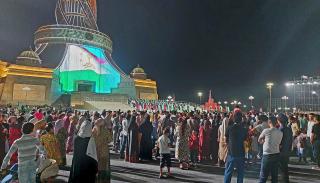
Breadcrumbs navigation
Post-Soviet power hierarchies in the making: Postcolonialism in Tajikistan’s relations with Russia
Karolina Kluczewska discusses the key points from her new Review of International Studies (RIS) article. If you'd like to know more you can read the full article at - Post-Soviet power hierarchies in the making: Postcolonialism in Tajikistan’s relations with Russia..
What does the ‘post-Soviet’ mean’?
Conceptually, this article is an intervention in favour of the concept of post-Sovietness which has been widely criticised in academic circles for its blurriness. Indeed, In IR and political science the ‘post-Soviet’ adjective has been used casually and attributed very different meanings.
Most often, the ‘post-Soviet’ refers to space, designating the territories of fifteen states which emerged after the breakup of the Soviet Union. This word is also often ascribed a temporal character, referring to political developments which took place after 1991. Simultaneously, the ‘post-Soviet’ became a catchword to describe and explain the persistence of certain governance traits which are detrimental from a liberal-democratic perspective, for instance bribing or centralisation of power. The ‘post-Soviet’ label was also questioned for its analytical inability to accurately capture the condition of fifteen states which emerged after the Soviet collapse, given significant differences between their political, economic and social dynamics. More recently, and particularly in the context of Russia’s war in Ukraine, some scholars saw the ‘post-Soviet’ designation as either epistemically unjust or legitimising Russia’s epistemic imperialism towards its neighbours.
Post-Soviet hierarchies in IR
While acknowledging these criticisms, the article argues that from an IR perspective post-Sovietness maintains an analytical potential. It is able to capture a unique structural condition in international relations: a distinct type of relationality which emerged between Russia, as the Soviet successor state, and other former Soviet republics. The post-Soviet system of stratification in world politics has its own distinct patterns of authority, legitimacy, control, subordination, and also subversion. In other words, rather than dismissing the post-Soviet, as scholars we should make use of it and refine it to enrich the IR theory – and in particular the emerging literature on various types of hierarchies in world politics with most prominent contributions of David Lake, Alexander Barder, and Janice Mattern and Ayşe Zarakol.
Briefly, the defining feature of post-Soviet power hierarchies is not so much the Soviet past, but the transition moment in 1991 in which the redistributive, joint command economy was replaced by capitalist economy. The type and scale of economic ties that emerged between Russia and other former Soviet republics within the new market economy framework are decisive for how post-Soviet hierarchies between them evolved.
Tajikistan’s relations with Russia
To provide a concrete illustration of how post-Soviet power hierarchies operate, the article analyses relations between two former Soviet states, Tajikistan and Russia. This case is not meant to be generalisable to other states – post-Soviet power hierarchies provide as a lens of analysis, rather than a theory which explains international relations. Moreover, rather than in Russia, I am primarily interested in Tajikistan’s perspective. Shifting the focus from a dominating to a subordinated party allows us to see not only how post-Soviet hierarchies are enforced, but also how they are perceived and navigated at political and social levels.
1991 was a critical moment in Tajikistan’s relations with Russia, as it marked a systemic rupture in economic relations between the Central Committee of the Communist Party of the Soviet Union in Moscow and the Tajik Soviet Socialist Republic. In Soviet times, their relationship was defined by a mixture of socially colonising and economically modernising tendencies, which overall make it difficult to call Tajikistan’s Soviet experience clear-cut colonial. Consequently, explicitly postcolonial features visible in Tajikistan’s relations with Russia after 1991 did not automatically result from the Soviet breakup. Instead, postcolonialism gradually emerged because of these two countries’ very different paths of integration into the global capitalist economy. Tajikistan, as the poorest country of the former Soviet Union, became subordinated to Russia, which currently belongs to the world’s upper middle-income economies. Following the Soviet collapse and independence, the two countries were reconnected through a new economic model which relies on a demand for cheap labour on the Russian market and a supply of labour force on Tajikistan’s side.
Currently, more than one million out of ten million citizens of Tajikistan are labour migrants in Russia, where they face both systemic discrimination and widespread societal xenophobia. In this way, the new linkage between the two countries, taking place within the global capitalist economy, exacerbated Soviet-era legacies and reinvented them in a new, hierarchical manner. If in Soviet times Slavic populations of the Soviet Union enjoyed a de facto higher social status than non-Slavs, including Tajiks, now citizens of Tajikistan became subordinated to Russian citizens as an exploited, disposable labour force serving Russia’s economy.
Hierarchies in flux
Post-Soviet power hierarchies start from economic relations, but they quickly expand to political and social perceptions. As the case of Tajikistan shows, the country’s economic subordination to Russia reinforced an ideational type of subordination and led to an interiorisation of inferiority by both Tajik policymakers and the broader society. The hierarchies started being locally perceived as natural and given.
As a final note, post-Soviet hierarchies are by no means static. They are constantly in the making, as world politics evolve. Tajikistan’s example shows that subordination to Russia can deepen over time. But the case of another former Soviet republic, Kazakhstan, suggests that hierarchies can also be gradually undone.
Want to know more? You can read the full article at DOI: https://doi.org/10.1017/S0260210524000287
BISA members receive access to RIS (and to our other journal European Journal of International Security) as a benefit of membership. To gain access, log in to your BISA account and scroll down to the 'Membership benefits' section. If you're not yet a member join today.
Top image: Celebrations of Tajikistan’s independence in September 2022. Image by Karolina Kluczewska


